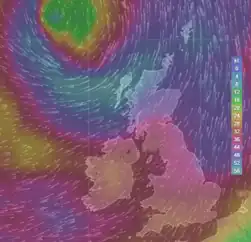Wind gust
A gust or wind gust is a brief increase in the speed of the wind, usually less than 20 seconds. It is of a more transient character than a squall, which lasts minutes, and is followed by a lull or slackening in the wind speed.[1] Generally, winds are least gusty over large water surfaces and most gusty over rough land and near high buildings.[2]

Definition
The wind is measured using an anemometer or estimated with a windsock. The average value of wind speed is generally measured over a period of 2 minutes before the meteorological observation according to the World Meteorological Organization. Any significant variation at this mean wind during the ten minutes preceding the observation are noted as gusts in messages such as METAR.[3]
It is generally reported in METAR when the peak wind speed reaches at least 16 knots and the variation in wind speed between the peaks and average wind is at least 9 to 10 knots.[1][4] In marine meteorology, the top speed of a burst is expressed in meters per second (m/s) or in knots, while the Beaufort scale is used for reporting the mean speed. When the maximum speed exceeds the average speed by 10 to 15 knots, the term gusts is used while strong gusts is used for departure of 15 to 25 knots, and violent gusts when it exceeds 25 knots.[4]
References
- "Gust". Glossary. American Meteorological Society. Retrieved November 15, 2018.
- "What causes wind gusts?". wxguys.ssec.wisc.edu. Retrieved 2021-11-28.
- World Meteorological Organization. "Gust amplitude". Eumetcal. Archived from the original on 2016-03-03. Retrieved November 15, 2018.
- "Rafale". Glossaire météorologique (in French). Météo-France. Retrieved November 15, 2018.